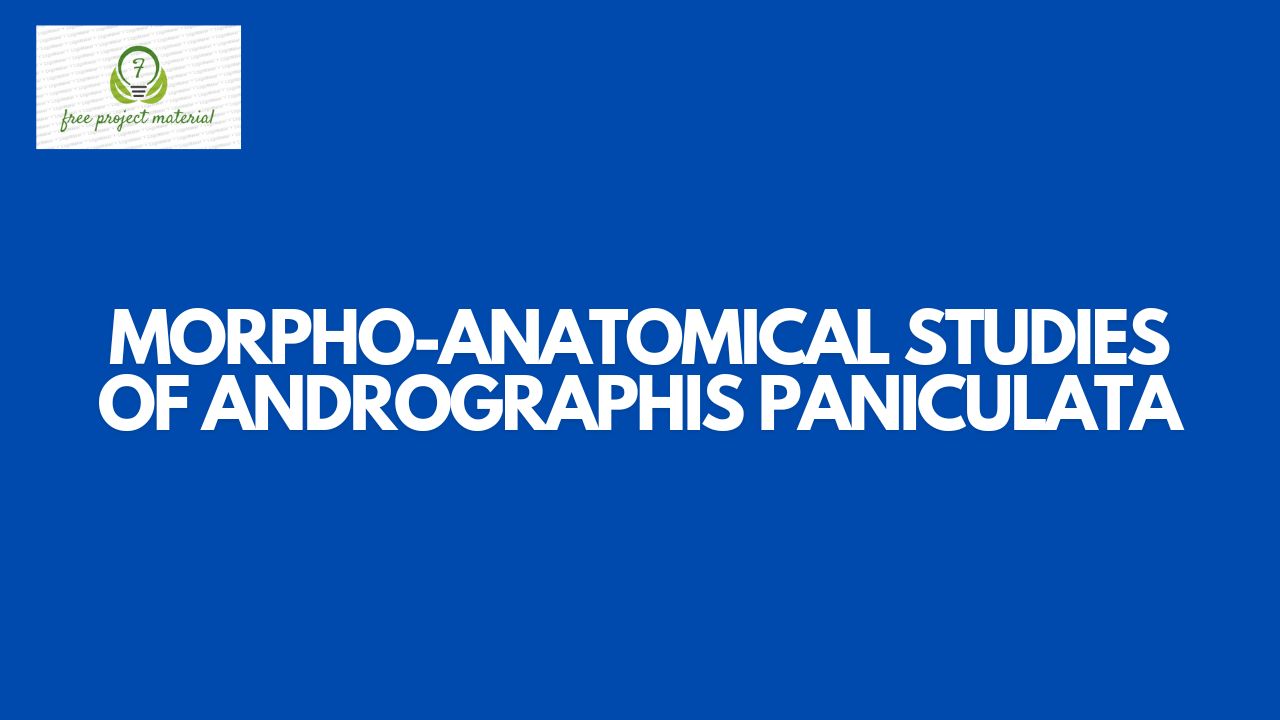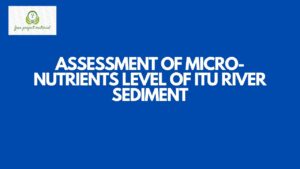ABSTRACT
Stomata and epidermal cell shape in A. paniculata were assessed to determined some diagnostic features that are peculiar in the leaves. Mature leaves were peeled, stained with safranin-O and examined under the microscope. Photographs were taken with Amscope digital camera. The stomata were diacytic. The stomata distribution was hypostomatic the anticlinal walls of the mature leaves were undulate one abaxial but sinuous on adaxial surface. The epidermal cell shapes were irregular on both surfaces. These features could serves as an important taxonomic tool in delimiting the species.
TABLE OF CONTENTS
Title Page – – – – – – – – – i
Certification – – – – – – – – ii
Dedication – – – – – – – – – iii
Acknowledgments – – – – – – – – iv-v
Abstract – – – – – – – – – vi
Table of Contents – – – – – – – – vii-viii
CHAPTER ONE: INTRODUCTION
1.1 Background of the Study – – – – – – 1-3
1.2 Aim and Objectives of the Study – – – – 3
1.2.1 Aim of the study – – – – – – – 3
1.2.2 Objectives of the Study – – – – – – 3-4
1.3 Scope and Limitation – – – – – – 4
1.4 Definition of Terms – – – – – – 4-5
CHAPTER TWO: LITERATURE REVIEW
2.1 Scientific Classification of Andrographis paniculata – 6
2.2 Origin and Distribution – – – – – – 7
2.3 Plant Description – – – – – – – 7
2.4 Ethnobotanical Uses – – – – – – 8
2.5 Phytoconstituents – – – – – – – 8-9
2.6 Pharmacological Activities of Andrographis paniculata – 9
2.6.1 Effect on Common Cold – – – – – – 10
2.6.2 Antiparasitic Effect – – – – – – 10
2.6.3 Anticancer Effect – – – – – – – 11-13
2.7 Toxicity of Andrographis paniculata – – – 13-14
CHAPTER THREE: MATERIALS AND METHODS
3.1 Materials – – – – – – – – 15
3.2 Methods – – – – – – – – 15
3.2.1 Sample Collection – – – – – – – 15
3.2.2 Epidermal Studies of Andrographis paniculata – – 15
3.3 Statistical Analysis – – – – – – – 16-17
CHAPTER FOUR: RESULTS AND DISCUSSION
4.1 Results – – – – – – – – 18-22
4.2 Discussion – – – – – – – – 23
CHAPTER FIVE: CONCLUSION AND RECOMMENDATION
5.1 Conclusion – – – – – – – – 24
5.2 Recommendations – – – – – – – 24
References
CHAPTER ONE: INTRODUCTION
1.1 Background of the Study
Medicinal plant is an integral part of human life to combat the sufferings from the dawn of civilization (Chaudhary et al., 2010). It is estimated that more than 80,000 of total plant species have been identified and used as medicinal plants around the world (Joy et al., 1998). Among these plants, more than 1300 plant species have been used traditionally in Malaysia where the knowledge is being passed down from generation to generation (Burkill et al., 1996). The indigenous medicinal plants and plant derived drugs are the potential source of alternative medicine and are extensively used to treat various health ailments (Kavishankar et al., 2011).use of the medicinal plants is a core component at primary health care level due to availability, acceptability, compatibility and affordability. Dependency on these medicinal plants varies from country to country. It is estimated that about 75-80% of people of developing countries and about 25% of people of developed countries depend either directly or indirectly on medicinal plants for the first line of treatment (Burkill et al., 1996).
Andrographis paniculata (Burn. f.) wall. Ex Nees is an important medicinal plant and widely used around the world. It belongs to the family Acanthaceae. It is used as a traditional herbal medicine in Pakistan, India and Malaysia (Kabir et al., 2014) and is ethnobotanically used for the treatment of snake bit, bug bite, diabetes, dysentery, fever and malaria (Burkill et al., 1996).
Active compounds contained in Andrographis paniculata, is actually of secondary metabolites, including economic stakes are diterpene classes, such as andrographolide (Akbar, 2011). Several research reports indicate that A. paniculata have morphological variations, levels of chemical compounds contained, as well as proving the existence of diversity because of differences in growth and environment. Akbar (2011), conducting research in the area of forest management Surakaita Central Java, getting that content andrographolide of A. paniculata, which grows in the middle plains 2.27% in the lowlands and height respectively of 1.37 and 0.89%. Meanwhile, in another study conducted by Hajiaghace and Akhondzadeh (2012) proves that the stomata density of Greenleaf Manzanita (Arctosta phlospatula) where higher in the leaves that were collected from the plateau (30.03 stomata. mm2). This study seek to uncover epidermal characteristics present in the leaf of A. paniculata.
1.2 Aim and Objectives of the Study
1.2.1 Aim of the study
The aim of this study is
- to identify some diagnostic features present in Andrographis paniculata
1.2.2 Objectives of the Study
The objectives of this study is:
(i) To assess the epidermal characters of Andrographis paniculata
(ii) To analyse the value obtained statistically by calculating the epidermal cell length and width, and stomata length and width.
1.3 Scope and Limitation
The scope and limitation of this research work focused on morpho-anatomical study of Andrographis paniculata due to ethical problem in this country.
1.4 Definition of Terms
Morpho-Anatomy: The study of anatomical forms and structures with emphasis on characteristics useful in distinguishing the species
Ethnobotany: Is the study of a region’s plant and their practical uses through the traditional knowledge of a local culture and people.
Adaxial Surface: Upper surface of the leaf
Abaxial Surface: lower surface of the leaf
Anticlinal wall: Occurring at right angles to the surface or circumference of a plant organ an anticlinal pattern of cell walls.
The diacytic stomata: This are stomata having guard cells surrounded by subsidiary cells.

